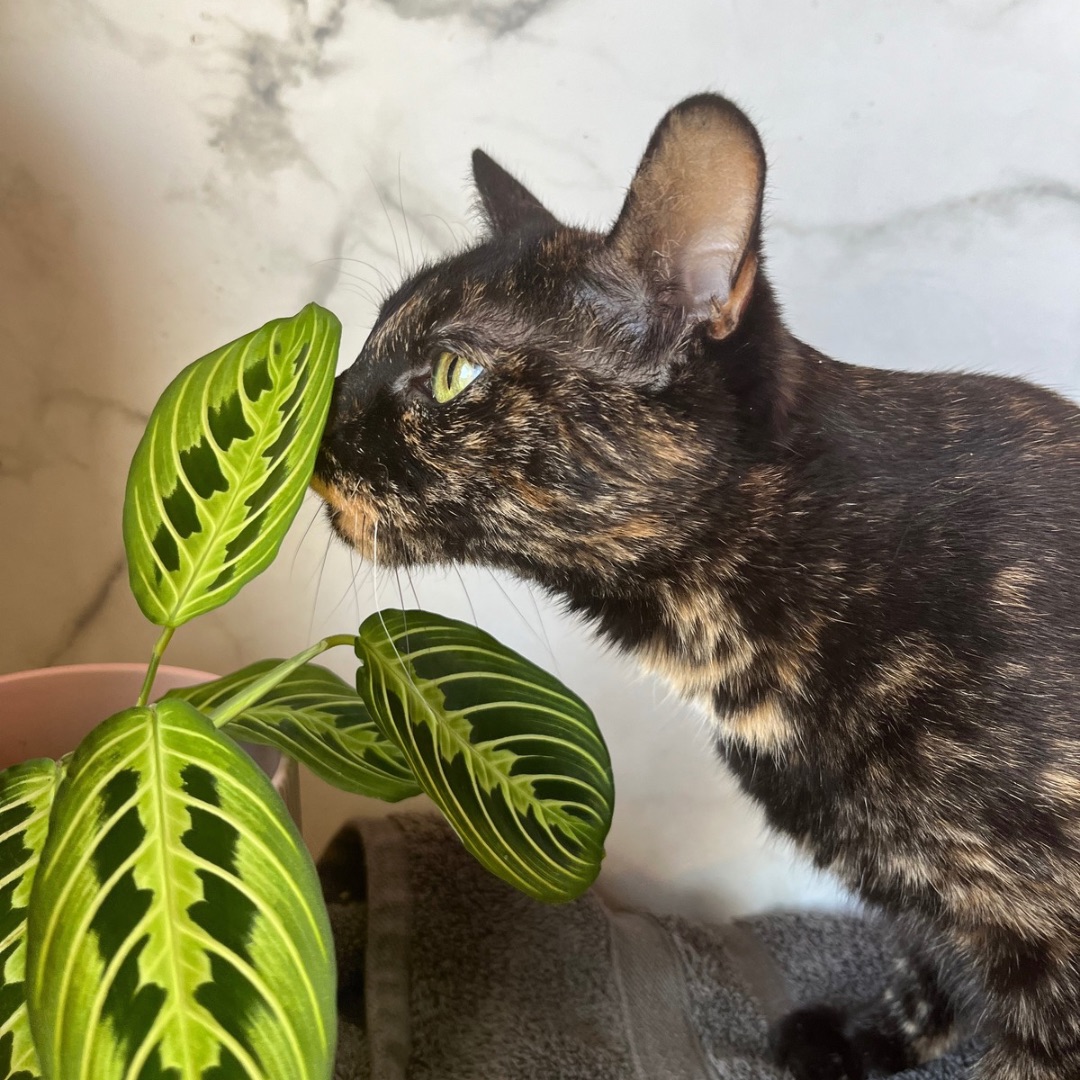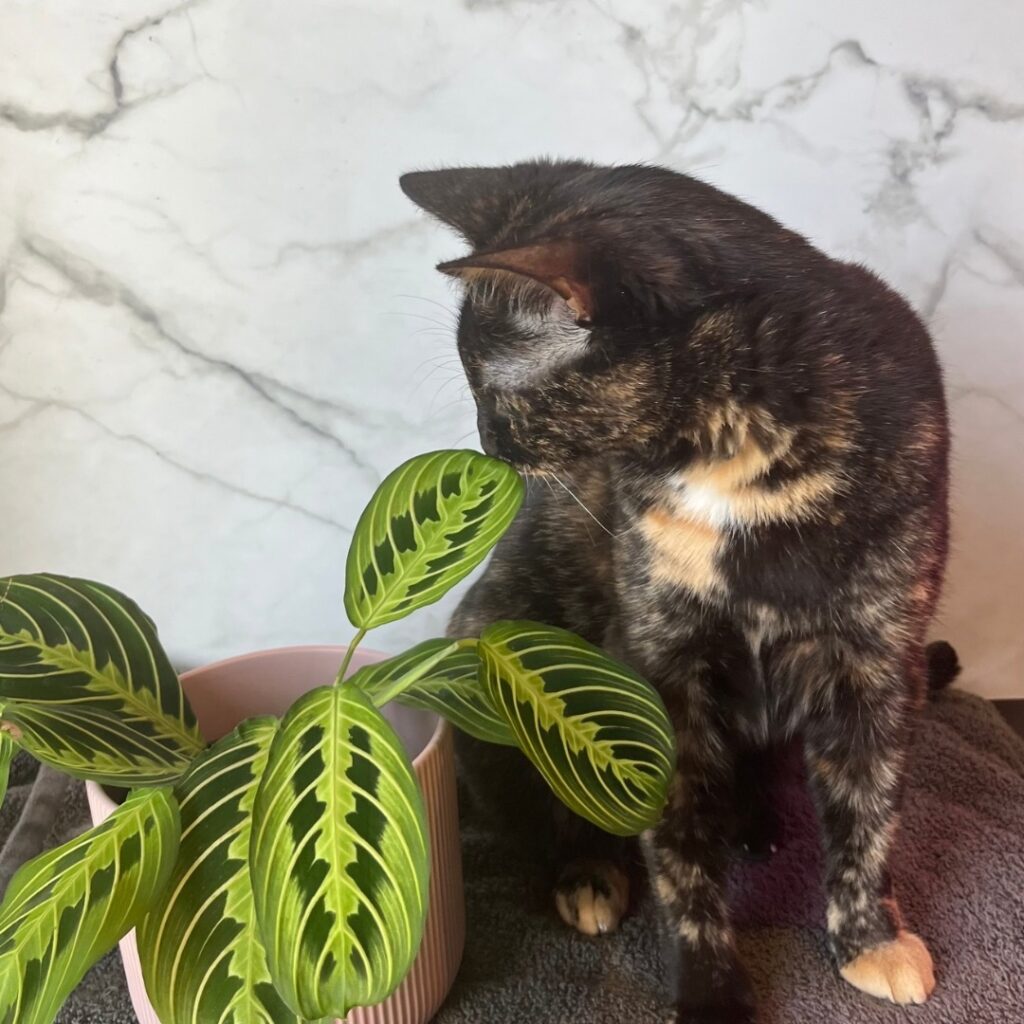
Is Maranta Lemon Lime Toxic to Cats?
There’s no denying that the beautiful, vibrant Lemon Lime Maranta (Maranta leuconeura’ Lemon Lime’) is a stunning addition to any home and space. And, especially compared to many other plants in the same family, their care is relatively easy. But is the Maranta Lemon Lime safe to have in your home if you share it with cats? If you’re like me, your world revolves around your furbabies, and you want to give them the best life possible – and avoid any kind of danger.
According to the ASPCA website, Marantas are non-toxic to cats and other animals like dogs and horses. While this is great news if your cat nibbles on your Maranta plant, it’s best to discourage your pets from eating your plants as there are other risks, including choking and impaction.
We’ll examine what makes Lemon Lime Marantas one of the safer options for cat parents, some of the dangers you should look out for, and how to keep Marantas in your home with cats to keep everyone safe and thriving.
Before we get started, I am not a veterinarian or a botanist. While I have taken all due care to research this topic and reference my personal experiences as a houseplant enthusiast and a cat owner, I won’t be held liable for any advice given here. This article is for informational purposes only. If you suspect your cat has eaten any of your houseplants or shows any signs of illness or discomfort, seek medical care immediately.
About Lemon Lime Maranta
Lemon Lime Marantas are members of the Marantaceae family. They are often called “Prayer Plants” because their beautiful, vibrant green foliage will fold upwards in the evenings, moving like hands praying. While they may not be suitable for all houseplant care styles (they need more care than a typical pothos or snake plant), their unique leaf patterns will turn heads in your home! The traditional red-veined maranta is very popular in shopping malls and offices due to its low light tolerance. The lemon lime variety offers a nice visual twist on a common houseplant!
I don’t know what it is about prayer plants and members of the Marantaceae family, but they tend to be my cat’s ideal choice for plants to nibble, so I always take care to keep them out of her reach. (More on that later.) I imagine that they are especially delicious tasting for animals.

Lemon Lime Maranta Toxicity
The ASPCA is considered one of the most trusted resources for direct answers on whether or not certain houseplants are toxic to pets (though I have found some inconsistencies with names and photos of certain plants). They list Maranta plants as non-toxic to cats, dogs and horses.
Why You Shouldn’t Let Your Cat Eat Your Maranta Lemon Lime (Even If They Are Considered Non-Toxic)
Just because a plant is considered non-toxic doesn’t mean it is entirely safe for your cats to devour your houseplants. Plants are not a key part of a cat’s natural diet and are typically eaten out of boredom or experimentation. This means their bodies are not designed to ingest plants in large quantities.
Digestive Upset
Just because a plant is considered non-toxic doesn’t mean that it won’t give your cat an upset stomach. Your cat can still experience nausea, vomiting, diarrhea, or other unpleasant digestive symptoms after eating a houseplant. What’s worse is that they will not understand exactly what is making their tummies upset. They will continue to eat that plant even after it has made them sick.
Other Toxins
While the plant itself is not considered toxic, many chemicals are used to care for it, like fertilizers and insecticides. This is especially dangerous if you use a systemic insecticide to treat your plants. Though highly effective in killing insects that nibble your plant, these chemicals also make the plant toxic to other creatures. Your plant will ingest those chemicals through the roots and in the vascular system.
Allergies
While uncommon, it is possible that your cat could suffer an allergic reaction. Since plants are not a big part of a cat’s typical diet (especially tropical plants that are not native to most areas), there is no way of knowing with certainty whether your cat is allergic to a plant until they eat it.
Impaction
One of the more sinister dangers of cats consuming plants is that it can result in an impaction. This happens when material that cannot be digested properly causes blockages in the intestine. Symptoms of this include:
- vomiting and diarrhea (sometimes bloody)
- abdomen tenderness (your cat may not let you touch them if it is severe)
- bloating
- lethargy
- struggling to defecate
- and loss of appetite.
This is very serious, so call your vet immediately if you notice any of these symptoms.
Choking
Since cats don’t typically consume plant foliage, it is always a concern that they may experience choking on the leaves and stems. Plant matter can become lodged in the throat or back of the mouth.
Why Won’t My Cat Leave My Lemon Lime Maranta Alone?
While there is a lot of controversy around whether keeping cats outdoors is safe and humane, cats were once undomesticated. They lived in the open world. There, they were exposed to plant life and foliage. So why are indoor cats so obsessed with our houseplants? Since we have domesticated cats, we have removed them from a lot of visual and olfactory stimulation. We do this for their safety and comfort, but many people do not consider that cats are natural hunters and need enrichment and play.
With proper stimulation and play, house cats can become very bored. They might take to exploring and acquainting themselves with anything in their homes. Our homes become the cat’s territory, so anything within it becomes attractive to them, especially if it is easily accessible. A new plant becomes novel and exciting! They want to explore it in any way they can, including nibbling or snacking on them. It’s up to us as cat guardians to make their homes (and ours) a safe environment. We can do this by providing them with enough enrichment to live their best cat lives.

Tips for Preventing Your Cat From Eating Your Lemon Lime Maranta Plant
So, your cat has taken an interest in your Maranta Lemon Lime. What can you do to keep the peace and keep your cat safe? I wrote an entire article on How to Keep Houseplants and Cats Together if you want to learn more about this, but here are some key tips:
Ultimately, you know your cat better than anyone! So you may have a good idea of which of these will work best for your cat’s ambitions and your home setup.
Overcrowding and Shelving
Shelving is a great way to keep plants off the ground and out of reach for cats. However, this is only effective if your cat isn’t likely to leap up onto the shelf. Mine certainly is, so I had to get creative.
Generally, cats won’t jump onto a shelf if there isn’t a landing space. So overcrowding a shelf with plants or decor can help to deter this. Unless of course if your kitty is on the lazy side and doesn’t seem willing to launch himself onto a shelf for a nibble.
Designated “Plant Rooms”
If you have a bedroom, office, or bathroom that is generally cat-free, you can keep your Lemon Lime Maranta in that particular room. I prefer to combine this practice with any of the others on this list just to be safe. I have had guests forget the “rules” and leave doors open, which can lead to disaster. But having that physical barrier is a great way to ensure that your cat isn’t eating your Lemon Lime.
Greenhouses, Cabinets, Terrariums, and Cloches
This is my favorite way to keep my houseplants out of reach of my cat, and fortunately, Lemon Lime Marantas can thrive in all of the above environments. I currently keep my Maranta in an Ikea Greenhouse Cabinet because it is on the larger side. However, if you have a cutting or a smaller plant, a sturdy cloche or even a terrarium is a great idea. If an Ikea cabinet like a MILSBO or a RUDSTA isn’t in your budget, if you don’t have the space, or if you’d rather not take your plant hobby to such extremes, there are other options. The ÅKERBÄR greenhouse is a smaller, budget-friendly choice, and my personal favorite is the SOCKER greenhouse.
Hanging Plants
Using hanging pots is a great solution for keeping your Maranta Lemon Lime out of reach for your cat. The Lemon Lime Maranta is perfect for this setup as it enjoys trailing. Macrame recently made a huge resurgence a few years back. This means there are so many fun pots, hangers and designs to choose from. The disco ball planters are on my wishlist!
With hanging plants, I always suggest avoiding dying leaves falling to the ground. Monitor your Lemon Lime Maranta carefully and prune any leaves that look like they may be on their way out.
Understanding Your Cat’s Behavior
Ultimately, you know your cat best! For example, my cat will stop at very few ends when it comes to getting a nibble of certain plants. This means my best course of action is to make them completely inaccessible to her. Keeping your cat active! Plenty of play, stimulation, and enrichment is another way to keep your cat away from your Lemon Lime Maranta. If you are looking for great resources to keep your cat happy and healthy, I always recommend Jackson Galaxy. He completely changed the way that I organize my home in a cat-friendly way.
If you are also looking for more info on how to stop your cat from eating your houseplants, check out this article I wrote here!


